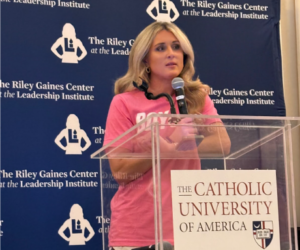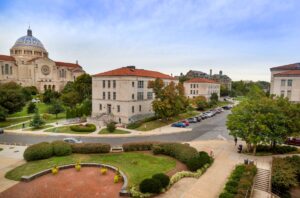Brookland Development Opposed By Residents
By Katie Ward
Brookland has long been a quiet, traditional neighborhood of D.C., with a “real sense of neighborhood cohesion,” according to a 2013 Washington Post article.
However, in recent years there has been a dialectical opposition between the “new”— young families, rising developments, college students, business changes— and the “old”— families who have raised generations in the same home for over fifty years, businesses that served as pillars of community, and people who made an investment in Brookland to own a home with a green yard and parking space.
Caught in the middle of this dialectic are the “200 footer” residents that surround the empty lot at 901 Monroe Street NE, so named for their homes’ under-200-foot proximity to the lot.
The lot, which used to be Colonel Brooks’ Tavern before closing in 2012, now lays deserted in the backyards of several Brookland families. These residents have ideas for the space’s development, but the plan currently being pushed through by local developers is for a seven-story apartment building similar to those at Monroe Street Market.
The D.C. Zoning Commission had approved the plan, but the order was vacated by the D.C. Court of Appeals when it found the plan to be “inconsistent with the D.C. comprehensive development plan.” Since then, the developer for the lot, the locally-headquartered Menkiti Group, has not submitted to the zoning commission a scaled-down proposal.
According to the development portfolio on its website, the Menkiti Group plans to house 213 residential units and 12,270 square feet of space; included in this space is “up to six new retail businesses, including a sit-down restaurant, 150 underground parking spaces and 66 bicycle parking spaces.”
Changes to the D.C. Office of Planning’s proposed plan include alterations to the Future Land Use Map and an endorsement of the “spot zoning” of 901 Monroe Street, according to Guy Durant, one of the most vocal of the “200-footers.”
“The 901 Monroe St. site is currently zoned to only allow a maximum of 40’ in height and 3 stories,” said Durant. “The 901 developer’s Comprehensive Plan proposal would result in a dramatic change in a low density residential area to allow 75’ and 7 stories.”
This proposition has been met with more backlash from the community, which originally halted the plan due to inconsistencies with the comprehensive development plan. The “upzoning” of the lot would change its designation from a low density to a high density area, and allow for a 7-story building just feet from the 200-footers’ back doors.
Dallas and Joan Wilson have lived in their house on 10th Street NE since 1977, and have seen the neighborhood go through many changes, including, in the last ten years, the demolition of Colonel Brooks’ Tavern and the vacant houses which filled up the rest of the block.
They’ve attended every meeting about the development of the lot and have been keeping updated about the proposed plans.
“At the last meeting there was a big blowout from residents,” said Joan. “The way they talked to us… They treated us like we were absolutely nothing. It’s a big mess around here.”
Her husband found error in the developer’s plans for the foundation of the proposed apartment building.
“They want to put an underground garage under there,” Dallas said. “But they had a reason for putting the low density designation. Brookland is built on water— you can hear it right in the name.”
The couple is concerned about the noise that would go on “all night long” during construction and the flooding that will happen in their backyard every time it rains, just like in the streets in front of their home.
Living within 200 feet of the proposed project, the Wilsons and Durant, among other families, have special rights of notice and appeal to the project.
“The current process calls for written submissions to the Office of Planning and eventually testimony before the D.C. City Council,” said Durant. “We shall see if the city listens only to developers and gives away ‘upzoning’ for nothing in return or if they listen to us and the affected community that asks for reasonable limits on development excess.”
However, there’s certainly no lack of benefits to the development of the property, according to ANC Commissioner 5B04 Ra Amin, who has been listening and advocating for residents’ points of view for the past year since taking office.
“Brookland has been known for its traditional residential (single family, row homes, maybe 3 stories high) buildings, yards, trees and green spaces, parking in front of your house– that’s what ‘traditional Brookland” is,” said Amin. “I see why people oppose a movement away from that– for many people, they made that investment when they moved here. But it’s unrealistic to think that this community would be the same as it was 40 years ago, any community.”
Amin says that a lot of that sentiment is generation. Families who purchased homes in the neighborhood forty years ago experience totally different things than someone who moved to the area five years ago– but a lot of the change has been good for the community.
His ultimate goal for the neighborhood is to “continue its growth into a livable, walkable community that has multi-modal transportation, look for sustainable ways of transportation and encourage people to come out of their cars a little more, bring those businesses into the community that people want, but also be mindful about preserving green space”.
“Traditionally, Ward 5 has been the more industrial ward and has always been a ward where the city thought to put services; it’s less expensive to lease and it’s metro accessible. ‘Smart growth’ is very important— we need to create a neighborhood everyone can afford and continue equity across the city.”
The president of the Brookland Neighborhood Civic Association, Dan Schramm, encourages that development happen “in a framework that makes sense, that we can promote.”
“Brookland is a stable, historical neighborhood,” he said. “Sensitivity and special thought should be given when developing to make any developments integrated and coherent with neighborhood character.”
Schramm echoed many of the same concerns that the 200-footers voiced. Ultimately, he said, Brookland is “one of the more stable neighborhoods in all of D.C., and people here have deep roots in the community.”
“Brookland is an arts-and-garden community, with great racial and economic diversity,” he said, “and people are afraid of losing that.”
The fight to continue to develop Brookland will have to be fought not behind closed doors or in individual meetings with district commissioners, as developers seem to be partial to, but in the same community meetings and online forums where the Brookland community comes together.
“Sometimes I walk out my door and ask ‘When did they put that there?'” said Joan, who is supportive of the development of the community but desires more resident input. “As long as I can fight them, I’m going to.”







